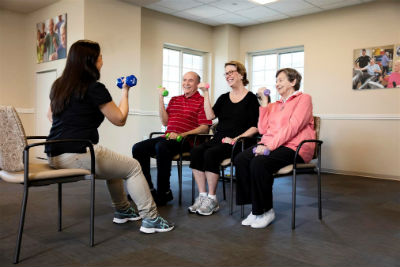In older adults, falls can lead to traumatic brain injury, hip fractures that reduce mobility and, in many cases, premature death. Late last year, the Memorial Hermann Post Acute Care Network began providing rehabilitation services at Belmont Village West University and Belmont Village Hunters Creek, two senior living communities located in the Houston residential areas of West University and Memorial. This summer, leadership at TIRR Memorial Hermann and Belmont Village piloted the innovative Otago exercise program at the West University and Hunters Creek locations, with plans to expand it to the other 23 Belmont Village senior living communities around the country.

“Our initial agreement with Belmont Village to provide home care, rehab therapy and hospice care through the Memorial Hermann Post Acute Care Network led to further discussions about fall prevention, an enormous problem for seniors and a major area of concern in assisted living,” says Anna de Joya, PT, DSc, NCS, director of new program development for Memorial Hermann Post Acute Care Services and manager of the Specialty Rehabilitation Program at TIRR Memorial Hermann. “The Otago program has been highly successful in the community setting but has never been adapted for assisted living.”
“When we teamed with TIRR and Memorial Hermann, our first goal was to bring their top-of-the line care and rehab services in-house,” says Patricia Will, Belmont Village founder and CEO. “Then we immediately began to explore how we could leverage this terrific partnership to not only add further value for our residents, but for all seniors. It started with providing discharged TIRR patients with a home-like environment where they can continue their rehab, which has been very successful. Now, the Otago program has the potential to proactively address what is often a life-changing event for older adults and one of our chief concerns as a care provider.”
De Joya was invited by Belmont Village COO Doug Lessard to make a presentation on the value of the program and provide recommendations on how to implement it. The response was positive. When Sheri Easton-Garrett, MSN, RN, joined Belmont Village as senior vice president of clinical services last February, she and De Joya began restructuring the facility’s fall-risk assessment using a multifactorial clinical approach.
“It was more than a matter of adapting the Otago exercises to the assisted-living setting,” Easton-Garrett says. “We had to build it into our clinical programs. Otago uses a very person-centered approach to preventing falls. We designed an in-depth nine-factor assessment of each resident that includes medical history, co-morbidities, mental status, history of falls, medical condition, vision status, medications, gait and balance and more, using a multidisciplinary approach.” Residents’ self-reported scores of their perception of fall risk are also important to the assessment. “As we age, our muscles weaken. Seniors who develop a fear of falling become overly cautious and engage in less activity, which can quickly lead to a downhill slide,” Easton-Garrett says. “It’s important that they continue to engage in activity that maintains their strength, balance and health.”
Belmont Village residents are evaluated and assessed as having a low, moderate or high fall risk. Those at low risk receive basic standardized education about falls and fall risk, along with their families, and are informed about exercise programs in the community. The assessment is completed every six months; any change in condition or a new event leads to a new assessment. For residents who are at moderate or high risk, Otago interventions are adapted to address areas where they need improvement and are included in their care plan.
Memorial Hermann Home Care physical therapy team members at Belmont Village were trained and certified in the program, a set of 17 exercises that includes strength training, balance retraining and walking skills.
After a six-week pilot at the West University assisted-living facility, the program was rolled out at Belmont Village Hunters Creek. “Our goal is to study these two communities and track our results,” Easton-Garrett says. “Otago has great promise. If we produce good results and can replicate them, we hope to implement the program at Belmont Village communities across the United States.”
“At TIRR Memorial Hermann, we’re excited about the program and the opportunity to collect outcomes,” De Joya says. “There’s currently no literature showing best-practices evidence related to a comprehensive fall prevention program in an assisted-living community. What we’re doing is pioneering.”
Easton-Garrett describes the Belmont Village program as evolving. “Falls are a leading cause of nonfatal injuries among seniors,” she says. “When you look at the emotional impact on residents and their families, the associated health care costs and the overall societal impact, a program that prevents the snowball effect of falls on health and can be replicated is a game-changer. We have to be flexible enough to examine it, evaluate it, take steps forward and still make changes when necessary.
“What I love about working with Anna and TIRR Memorial Hermann is that they embrace the entire clinical, research and educational vision of community health,” Easton-Garrett says. “We’ll continue to look at new ways to prevent falls and improve health. If we can move the fall-risk needle, it will be a great accomplishment.”
1Centers for Disease Control and Prevention. About CDC’s Injury Center. www.cdc.gov/injury/about/index.html. 2011 Aug 2.